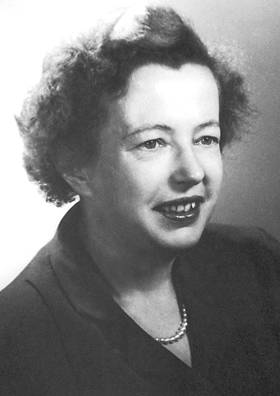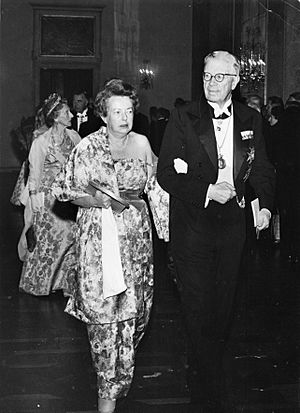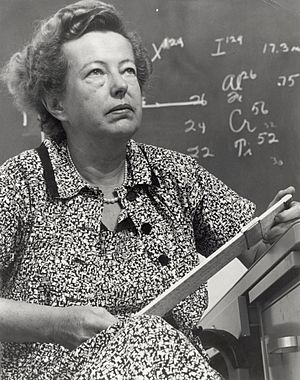Maria Goeppert Mayer facts for kids
Quick facts for kids
Maria Goeppert Mayer
|
|
|---|---|

Mayer in 1963
|
|
| Born |
Maria Göppert
June 28, 1906 |
| Died | February 20, 1972 (aged 65) San Diego, California, U.S.
|
| Citizenship | Germany United States |
| Alma mater | University of Göttingen |
| Known for | Double beta decay Magic number Nuclear shell model Two-photon absorption Goeppert Mayer unit |
| Spouse(s) |
Joseph Edward Mayer
(m. 1930) |
| Children | 2 |
| Awards | Nobel Prize in Physics (1963) |
| Scientific career | |
| Fields | Physics |
| Institutions | Sarah Lawrence College Columbia University Los Alamos Laboratory Argonne National Laboratory University of California, San Diego University of Chicago |
| Doctoral advisor | Max Born |
| Doctoral students | Robert G. Sachs |
| Signature | |
Maria Goeppert Mayer (June 28, 1906 – February 20, 1972) was a German-born American physicist. She won the Nobel Prize in Physics for her ideas about how the inside of an atomic nucleus is built. She was the second woman ever to win a Nobel Prize in physics. The first was Marie Curie.
Maria Goeppert Mayer studied at the University of Göttingen. Her PhD work was about how atoms can absorb light in a special way, called two-photon absorption. At the time, it was hard to test her ideas. But when lasers were invented in the 1960s, scientists could finally prove her theory. Today, there's even a unit named after her, the Goeppert Mayer (GM) unit, used for measuring this type of light absorption.
Maria married Joseph Edward Mayer and moved to the United States. Because of strict rules against family members working together at universities, she often had unpaid positions. During World War II, she worked on the Manhattan Project. This project aimed to develop the first atomic bombs.
After the war, she became a professor at the University of Chicago and a scientist at Argonne National Laboratory. There, she created a mathematical model for the structure of the atomic nucleus. This important work earned her the Nobel Prize in Physics in 1963. She shared the prize with two other scientists, J. Hans D. Jensen and Eugene Wigner. Later, she became a full professor at the University of California, San Diego.
Contents
Early Life and Education
Maria Göppert was born on June 28, 1906, in Kattowitz. This city is now called Katowice and is in Poland. She was the only child of her parents. In 1910, her family moved to Göttingen, Germany. Her father became a professor at the University of Göttingen. Maria was very close to her father, who was also a scientist.
Maria went to a special school in Göttingen for girls who wanted to go to university. In 1921, she joined a private high school run by women who supported equal rights. This school helped girls get ready for university. She took her university entrance exam, called the abitur, when she was 17. She passed, and so did all the other girls from her school who took the exam.
In 1924, Maria started at the University of Göttingen. She first studied mathematics. But she soon became very interested in physics and decided to get her PhD in that field.
Her PhD Work
In 1930, Maria finished her PhD. Her main work was on the theory of two-photon absorption. This is a process where an atom absorbs two light particles (photons) at the same time. At first, it was hard to test her ideas in a lab. But in 1961, after lasers were invented, scientists proved her theory. To honor her work, the unit for measuring two-photon absorption is called the "GM" (Goeppert Mayer).
Maria's examiners for her PhD were three scientists who later won Nobel Prizes themselves. They were Max Born, James Franck, and Adolf Otto Reinhold Windaus.
Marriage and Move to the US
On January 19, 1930, Maria married Joseph Edward Mayer. He was an American scientist who was working with James Franck. They had met when Joseph stayed with Maria's family. After they married, the couple moved to the United States. Joseph had a job as a chemistry professor at Johns Hopkins University. Maria and Joseph later had two children, Maria Ann and Peter Conrad.
Working in the United States
At Johns Hopkins University, Maria faced a challenge. The university had strict rules against nepotism. This meant they usually didn't hire family members of professors. These rules often made it hard for women married to professors to get jobs. So, Maria was given a low-paying job as an assistant. She helped with German letters and had a place to work. She also taught some classes. In 1935, she published an important paper on double beta decay.
Maria worked with other scientists at Johns Hopkins. She also went back to Göttingen in the summers to work with her former professor, Max Born. This stopped when the Nazi Party came to power in Germany in 1933. Many scientists, including Born, lost their jobs because of new laws. Maria and others helped scientists who had to leave Germany.
In 1937, Joseph Mayer lost his job. He believed it was partly because of Maria working in the lab. The family then moved to New York. Joseph got a job at Columbia University. The head of the physics department there gave Maria an office, but she still didn't get a salary. She became friends with famous scientists like Harold Urey and Enrico Fermi. Fermi asked her to study new, undiscovered elements. Her predictions about these elements turned out to be correct. In 1941, she became a member of the American Physical Society.
The Manhattan Project
In December 1941, Maria Goeppert Mayer got her first paid teaching job at Sarah Lawrence College. In 1942, during World War II, she joined the Manhattan Project. This was a secret project to build the first atomic bomb. She worked at Columbia University on separating different types of uranium. This was a very important step in making the atomic bomb.
Later, she joined Edward Teller's group at the Los Alamos Laboratory. This lab was a key part of the Manhattan Project. There, she worked on understanding materials at very high temperatures. This research was important for developing powerful thermonuclear weapons.
After the war, in 1946, Maria's husband Joseph became a professor at the University of Chicago. Maria also became a voluntary associate professor of physics there. She also got a part-time job as a senior physicist at the nearby Argonne National Laboratory. Even though she said she didn't know much about nuclear physics, she learned quickly. She used early computers to solve complex problems related to nuclear reactors.
Discovering the Nuclear Shell Model

While working in Chicago and at Argonne in the late 1940s, Maria Goeppert Mayer made her most famous discovery. She developed a mathematical model for the structure of atomic nuclei. Her model explained why some atomic nuclei are much more stable than others. This happens when the nucleus has a certain number of protons or neutrons, which are called magic numbers. These numbers are 2, 8, 20, 28, 50, 82, and 126.
Maria had a key idea while talking with Enrico Fermi. She realized that the nucleus is made of layers, like an onion, and that pairs of protons and neutrons tend to stick together.
Three German scientists were working on the same problem and came up with similar ideas around the same time. Maria Goeppert Mayer then worked with them. In 1950, she wrote a book with Hans Jensen called Elementary Theory of Nuclear Shell Structure.
In 1963, Maria Goeppert Mayer, Hans Jensen, and Eugene Wigner shared the Nobel Prize in Physics. They won "for their discoveries concerning nuclear shell structure." Maria was the second woman to win the Nobel Prize in physics.
Later Life and Legacy

In 1960, Maria Goeppert Mayer became a full professor of physics at the University of California, San Diego. Soon after, she had a stroke, but she kept teaching and doing research for several years. She was recognized by many important groups for her work.
Maria Goeppert Mayer passed away in San Diego, California, on February 20, 1972, after a heart attack. She is buried in San Diego.
After her death, the American Physical Society created the Maria Goeppert Mayer Award. This award honors young female physicists at the start of their careers. Argonne National Laboratory also gives an award each year to a talented young woman scientist or engineer in her honor. The University of California, San Diego hosts an annual event called the Maria Goeppert Mayer symposium, where female researchers discuss science.
There is even a crater on the planet Venus named after her! In 1996, she was added to the National Women's Hall of Fame. In 2011, she was featured on a US postage stamp. Her papers are kept at the Geisel Library at the University of California, San Diego. The physics building at the university, Mayer Hall, is named after her and her husband.
See also


